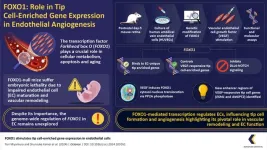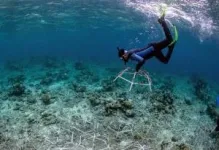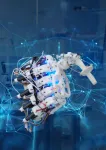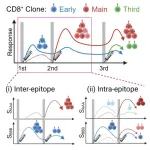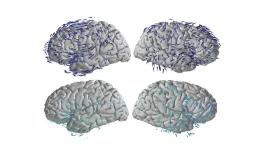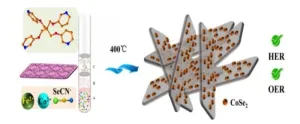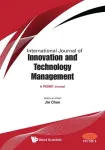(Press-News.org) The human vascular system, a complex network of blood vessels, plays an essential role in maintaining health. Understanding the molecular mechanisms underlying vascular development is important for tackling age-related disorders. The Forkhead box O (FOXO1) transcription factor is crucial in processes related to aging, cellular metabolism, and apoptosis. Despite its significance, the comprehensive regulation of FOXO1 across the genome in endothelial cells (EC) has not been investigated.
In a new paper published in iScience in February 2024, a research team from Kumamoto University employed advanced techniques, including next-generation sequencing to comprehensively analyze vascular ECs stimulated by the potent vascular endothelial growth factor (VEGF) and were subjected to a comprehensive analysis. This allowed the team to observe sequential changes in the cellular localization of FOXO1, providing unique insights into its dynamic role during prolonged VEGF stimulation. The corresponding author of the paper, Professor Takashi Minami explains, "We uncovered cell type-specific functions of FOXO1, shedding light on its role in VEGF-mediated Tip cell definition in primary cultured endothelial cells. Our study explores novel pathways for understanding FOXO1's functions in cellular processes, offering insights into vascular biology."
The researchers focused on blood vessel development by studying the role of FOXO1 in ECs, examining how FOXO1 influences gene activity during VEGF-induced vessel remodeling. To understand this, the research team used techniques of immunostaining on mouse retina tissues and spheroid assays with human ECs. They observed FOXO1 localization in Tip cells, crucial for blood vessel sprouting. The study also investigated FOXO1 dynamics upon VEGF treatment and chemical inhibitors to understand the involvement of various signaling pathways in this process.
Moreover, using advanced genomic analyses, researchers identified FOXO1-regulated genes involved in vessel maturation. The study's unique approach included ChIP-seq and RNA-seq analyses, providing insights into FOXO1's direct binding to specific gene regions. Professor Minami says, "Recognizing the critical need to understand the mechanism governing the definition of Tip versus stalk cells during sprout maturation and the role of FOXO1 activity in VEGF-mediated vessel remodeling, we conducted a study that assessed FOXO1-regulated genes through single-cell RNA-seq and Chip-seq analyses in VEGF-treated ECs."
The researchers focused on the transcriptional system governing Tip-Stalk determination. Prolonged VEGF stimulation, FOXO1 undergoes a remarkable translocation to the nucleus specifically in Tip cells, a critical phase in vascular branching. This activated state triggers the expression of genes that determine the fate of Tip cells. Simultaneously, FOXO1 inhibits NOTCH signaling in stalk cells, responsible for cell proliferation. Importantly, NOTCH signaling reciprocally hinders FOXO signaling, preventing stalk cells from adopting Tip cell characteristics. FOXO1 shows a distinctive binding to endothelial cells-unique Tip cell-enriched genes. The study also identified new enhancer regions for VEGF-responsive Tip cell genes (ESM1 and ANGPT2).
In conclusion, these findings shed light on FOXO1's crucial role in ECs during blood vessel formation, particularly in the context of VEGF-induced angiogenesis. While Tip cells guide the direction of vascular branching, stalk cells support the growth of the emerging vessels. This finding not only deepens our understanding of vascular remodeling but also emphasizes the cell-specific functions of FOXO1.
Moreover, they provide a comprehensive understanding of the aging-associated decline in vascular health and pave the way for exploring novel mechanisms to counteract vascular diseases such as metastatic cancer and recurrent cardiovascular diseases. Offering the potential to enhance overall health in an aging population and ways to manage diseases in the future, this study proves to be a significant achievement in the field of vascular biology.
About Professor Takashi Minami
Professor Takashi Minami is the head of the Molecular Vascular Control Field. Prof. Minami, formerly a postdoctoral researcher and instructor at MIT and Harvard Medical School's Beth Israel Deaconess Medical Center, brings over 13 years of experience as an associate professor and professor at the University of Tokyo's Center for Advanced Science and Technology, where he led the 'Vascular Biology Laboratory.' He has contributed to 32 research papers and 17 research projects. Prof. Minami specializes in research on the growth and regeneration of blood vessels, as well as studies to elucidate the mechanism of diseases related to blood vessels.
END
Unveiling the role of FOXO1 in vascular development and transcriptional dynamics in endothelial cells
With extended vascular endothelial growth factor (VEGF) exposure, FOXO1 translocates to the nucleus in Tip cells, guiding vascular branching
2024-03-08
ELSE PRESS RELEASES FROM THIS DATE:
Call for papers| Special Issue on advanced robotics and tissue engineering
2024-03-08
Scope
For decades, robotic systems have played a pivotal role in nurturing the growth of tissue-engineered constructs in controlled environments through the provision of mechanical stimulation. The importance of physical stresses in tissue maturation is not only intuitive from our own bodily experiences but is also supported by a growing body of mechanotransduction research. However, experimental studies have predominantly remained confined to basic in vitro setups, hampering our ability to produce functional grafts that can translate into clinical practice. Emerging evidence suggests that replicating physiological stresses more faithfully could further enhance the functionality of tissue ...
Optimizing boosters: How COVID mRNA vaccines reshape immune memory after each dose
2024-03-08
mRNA vaccines developed against the spike glycoprotein of severe acute respiratory syndrome type 2 coronavirus (SARS-CoV-2), displayed remarkable efficiency in combating coronavirus 19 (COVID-19). These vaccines work by triggering both cellular and humoral immune responses against the spike protein of the virus. Cellular immunity may play a more protective role than humoral immunity to variants of concerns (VOC) against SARS-CoV-2, as it targets the conserved regions of spike protein and possibly cross-reacts with other variants.
Since a single spike epitope is recognized by multiple T-cell clones, the ...
Mapping the future’s sweet spot for clean energy and biodiversity
2024-03-08
Climate change is driving both the loss of biodiversity and the need for clean, renewable energy. It is also shifting where species are expected to live in the future. Yet these realities are rarely considered together. Where can clean energy projects be built without impacting the future habitat ranges of threatened and endangered species?
A study from the University of California, Davis, examines this question by overlaying renewable energy siting maps with the ranges of two species in the southwestern United States: the iconic and climate-vulnerable ...
Brain waves travel in one direction when memories are made and the opposite when recalled
2024-03-08
In the space of just a few seconds, a person walking down a city block might check their phone, yawn, worry about making rent, and adjust their path to avoid a puddle. The smell from a food cart could suddenly conjure a memory from childhood, or they could notice a rat eating a slice of pizza and store the image as a new memory.
For most people, shifting through behaviors quickly and seamlessly is a mundane part of everyday life.
For neuroscientists, it’s one of the brain’s most remarkable capabilities. That’s because different activities require the brain to use different combinations of its many regions and billions of neurons. How ...
Lack of focus doesn’t equal lack of intelligence — it’s proof of an intricate brain
2024-03-08
By Gretchen Schrafft, Science Communications Specialist, Robert J. & Nancy D. Carney Institute for Brain Science
PROVIDENCE, R.I. [Brown University] — Imagine a busy restaurant: dishes clattering, music playing, people talking loudly over one another. It’s a wonder that anyone in that kind of environment can focus enough to have a conversation. A new study by researchers at Brown University’s Carney Institute for Brain Science provides some of the most detailed insights yet into the brain mechanisms that help people pay attention amid such distraction, as well as what’s ...
Many type 2 diabetes patients lack potentially life-saving knowledge about their disease
2024-03-08
The body's inability to produce enough insulin or use it effectively often results in type 2 diabetes (T2D), a chronic disease affecting hundreds of millions of people around the globe. Disease management is crucial to avoid negative long-term outcomes, such as limb amputation or heart disease. To counteract adverse consequences, it is crucial that patients have good knowledge about the day-to-day management of the disease.
A team of researchers in Portugal has now assessed how many patients – both insulin-treated and not insulin-treated – have this crucial knowledge about T2D. They published their findings in Frontiers in Public Health.
“Our main motivation ...
Small class sizes not better for pupils’ grades or resilience, says study
2024-03-08
Smaller class sizes in schools are failing to increase the resilience of children from low-income families, according to a study published in the peer-reviewed International Journal of Science Education.
Data on more than 2,700 disadvantaged secondary (high) school students shows that minimizing pupil numbers in classrooms does not lead to better grades. Reducing class sizes could even decrease the odds of children achieving the best results, say the study authors.
The quantity of teachers also does not increase the odds of pupils from the poorest backgrounds achieving academically, despite concerns over staff shortages in schools.
Instead, the researchers ...
Two-dimensional bimetallic selenium-containing metal-organic frameworks and their calcinated derivatives as electrocatalysts for overall water splitting
2024-03-08
Transition metal selenides have been considered to be a good choice for electrocatalytic water splitting. In addition, Metal-organic frameworks (MOFs) have been used to make catalysts with good electrocatalytic capabilities. Traditionally, the MOF-derived selenides are produced via the self-sacrificing MOF template methods. However, this strategy is high-energy consuming, and it is difficult to precisely control the structure and component homogeneity of the product during pyrolysis.
A research group of Wang-ting Lu, Fan Yu, and Yun Zheng ...
An increase in the number of extreme cold days in North China during 2003–2012
2024-03-08
How extreme weather and climate events change is an intriguing issue in the context of global warming. As IPCC AR6 points out, cold extremes have become less frequent and less severe since the 1950s, mainly driven by human-induced climate change. However, cold extremes could also exhibit robust interdecadal changes at regional scale.
A recent study by researchers from the Institute of Atmospheric Physics, Chinese Academy of Sciences, presents robust interdecadal changes in the number of extreme cold days in winter over North China during 1989–2021, and the findings have been published in Atmospheric and Oceanic Science Letters. ...
Open creativity: Increased creativity due to network relationships
2024-03-08
This paper's objective is to show that the network of frequent relationships that is established between agents in coworking environments, through weak ties, increases the generation of ideas. Thus, the present work argues that collaborative spaces can expand individuals' creativity, as they constitute a social hub for exchanging experiences and visions between individuals from different social and professional backgrounds [Blagoev et al. (2019)]. Through frequent relationships and weak ties, these social connections allow individuals to access different levels of insights and inspirations that make it possible to ...
LAST 30 PRESS RELEASES:
Norbert Holtkamp appointed director of Fermi National Accelerator Laboratory
New agentic AI platform accelerates advanced optics design
Biologists discover neurons use physical signals — not electricity — to stabilize communication
Researchers discover that a hormone can access the brain by hitchhiking
University of Oklahoma researcher awarded funding to pursue AI-powered material design
Exploring how the visual system recovers following injury
Support for parents with infants at pediatric check-ups leads to better reading and math skills in elementary school
Kids’ behavioral health is a growing share of family health costs
Day & night: Cancer disrupts the brain’s natural rhythm
COVID-19 vaccination significantly reduces risk to pregnant women and baby
The role of vaccination in maternal and perinatal outcomes associated with COVID-19 in pregnancy
Mayo Clinic smartwatch system helps parents shorten and defuse children's severe tantrums early
Behavioral health spending spikes to 40% of all children’s health expenditures, nearly doubling in a decade
Digital cognitive behavioral treatment for generalized anxiety disorder
Expenditures for pediatric behavioral health care over time and estimated family financial burden
Air conditioning in nursing homes and mortality during extreme heat
The Alps to lose a record number of glaciers in the next decade
What makes a good proton conductor?
New science reporting guide published for journalists in Bulgaria
New international study reveals major survival gaps among children with cancer
New science reporting guide published for journalists in Turkey
Scientists develop a smarter mRNA therapy that knows which cells to target
Neuroanatomy-informed brain–machine hybrid intelligence for robust acoustic target detection
Eight SwRI hydrogen projects funded by ENERGYWERX
The Lundquist Institute and its start-up company Vitalex Biosciences Announces Strategic Advancement of Second-Generation fungal Vaccine VXV-01 through Phase 1 Trials under $40 Million Competitive Con
Fine particles in pollution are associated with early signs of autoimmune disease
Review article | Towards a Global Ground-Based Earth Observatory (GGBEO): Leveraging existing systems and networks
Penn and UMich create world’s smallest programmable, autonomous robots
Cleveland researchers launch first major study to address ‘hidden performance killer’ in athletes
To connect across politics, try saying what you oppose
[Press-News.org] Unveiling the role of FOXO1 in vascular development and transcriptional dynamics in endothelial cellsWith extended vascular endothelial growth factor (VEGF) exposure, FOXO1 translocates to the nucleus in Tip cells, guiding vascular branching
